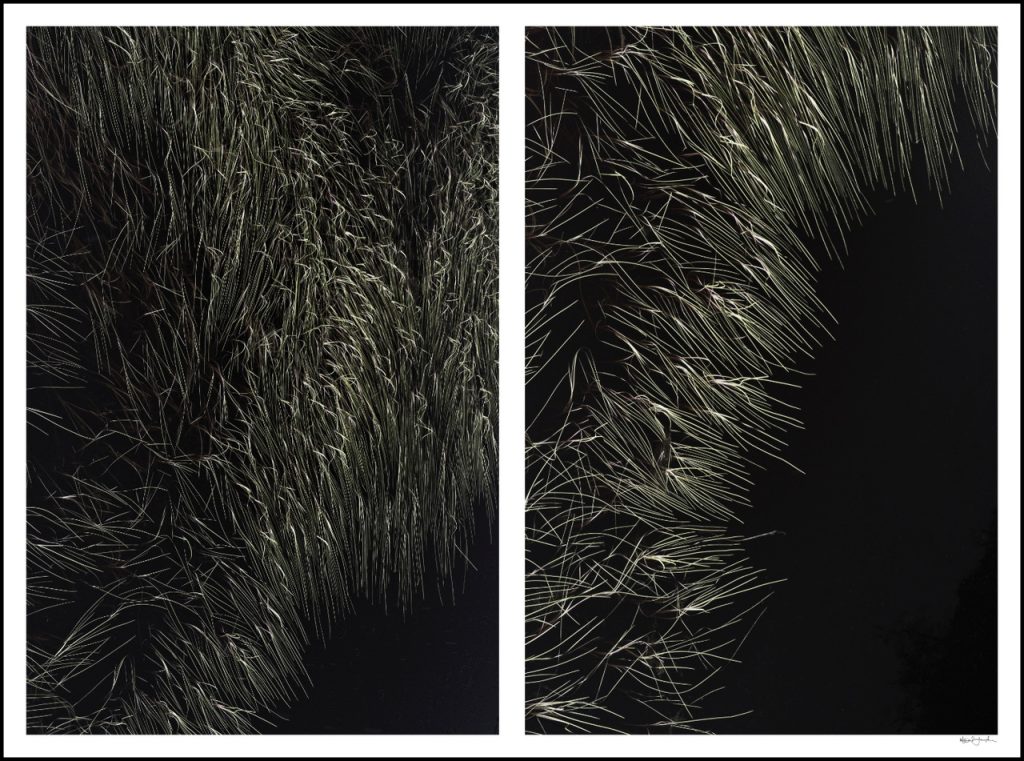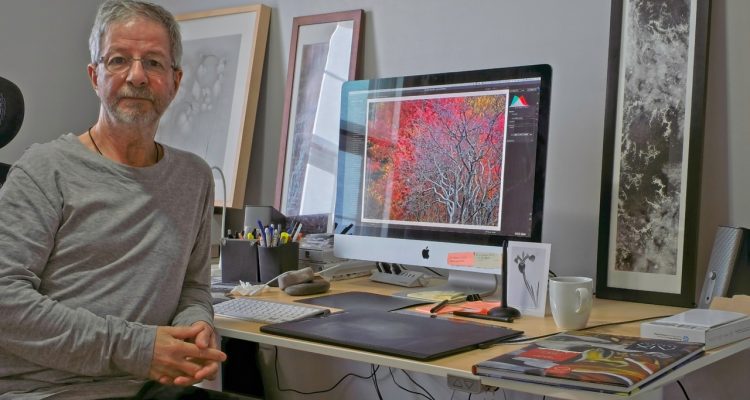“Inspired by nature…”
Paul Zimmerman in conversation with Marcel Jomphe
Paul Zimmerman: How did you get interested in art?
Marcel Jomphe: My interest in the arts started in elementary school. My 6th grade teacher gave me confidence and that’s when I started drawing and discovered that I had a skill for so-called observational or representational drawing. Subsequently, I studied graphic design in order to be able to live in one way or another from my drawing and it was at that time, at the age of 20, that I discovered the field of scientific illustration and a particular interest for the organic architecture or design of the plant kingdom. I saw that there was an opportunity there for me to earn my living as an artist with honesty and integrity while providing service to society. With luck I was able to work in this field for over thirty years. I probably drew more than a thousand species of plants which allowed me to develop my technique. Today, I left the field of scientific illustration to concentrate and develop my personal artistic expression.
My interest in nature photography started in the 70s and developed alongside my work as a draftsman. Since I spent my days drawing for a living, I could not simultaneously continue drawing in the evenings and on weekends on more personal works. This is how photography became my second medium of expression. Photography allowed me to be in nature, to take long walks, to bring my sons with me and to introduce them to the love of nature. It allowed me to explore and memorize the subtle language of nature design. I thus acquired a very fine sense of observation.
PZ: Your works include drawings and photographs. What do you prefer?
MJ: Photography is for me a privileged tool to explore nature and accumulate an image bank and develop my visual memory, but my favorite language remains drawing. What interests me now is the drawing by imagination based on my memory of the shapes that I have observed during those years. In parallel to the work of drawing, photography allows me to develop my sensitivity for the design of forms that I can then transfer to my other media. Drawing is hard. It takes time, discipline, focus, patience, perseverance, persistence, and dedication. Graphite is an excellent way to cultivate knowledge and sensitivity for design. As a draftsman I now design objects or organic forms, I do not copy them. It is clear for example that the Mandala series of drawings is inspired by natural forms observed in nature, but these forms are imaginary and do not represent any real organism. They are pure imagination.
PZ: What is your artistic process? How do you create your works?
MJ: I meditate for a long time on my compositions. Certain images remain in me for years and a day comes when these images materialize. I never rush the execution of a drawing. I let inspiration makes its way over the hours of work. I first work on the line art and the three-dimensionality of the shapes. I learned to see the space in the white of the paper and this negative space is very important for the composition. When the formal structure is in place, I add shadows and lights. I normally work with graphite as well as brush and ink, but I am also very comfortable with new technologies and I recently challenged myself and decided to develop the technique of digital drawing using a graphic tablet and a dedicated drawing software. Therefore, my next drawings would most probably be produced digitally. In 2007, I made the transition to digital photography and was excited with the freedom and possibilities of exploration that it gave me. Being able to control the entire creative process, from shooting to post-processing to printing, really interested me a lot and allowed me to develop myself as a photographer. I intend now to do the same with my drawings, from creation to printing.
In representational art, drawing is one of the basic skills necessary to communicate one’s artistic message. Good drawing is successful coordination of eyes, mind and hand. To draw well, we must develop the ability to look at subjects and see relationships and proportions among shapes. And this takes a lifetime to develop.

PZ: . Do you have any particular goal in mind when you start a new piece?
MJ: While my processes are mainly intuitive, my goal is to communicate my perception and understanding of the design of shapes in nature. I want my works to create calm and a feeling of grace in relation to the energy of nature. I want people to be able to immerse themselves for a long time in my works and that these works join them from the inside. And, at the end of the day, I wish a certain energy and a bond remain between us. It may sound very spiritual to some, but for me as an artist it is very important to communicate beauty rather than ugliness, disasters, sarcasm and negativity. In these difficult days, we need to find the essential and for me the essential is the connection with nature.
PZ: How do you know when the painting is finished?
MJ: There comes a time when I look at a drawing and try to see what I could add to it and find nothing. I know then that it is finished. It happens naturally. It is actually quite intuitive. For photography it is more difficult. As I work more and more by series, it seems as if it’s never finished and that I can again and again make a better selection, add or remove a photo, change the direction of the subject, etc. It’s a long process of investigation and sometimes I have to rely on rigid constraints to complete a project.
PZ: Has your practice changed over time?
MJ: Over time there is a calm that settles in my practice. I believe it came from my inner learning and my understanding of the fundamentals. We cannot communicate something that we do not understand. Drawing is a language that takes a lifetime to master, and with time and experience a serenity sets in which allows me greater freedom in my expression. I am in a good period of my life in terms of expressive abilities and I believe that over time I will be able to produce works that will satisfy me more and more.
PZ: Which artists are you most influenced by?
MJ: The first great draftsman who influenced me and who still influences me is undoubtedly Ernst Haeckel. I own books of most of his works and I never tire of looking at these magnificent drawings. Also, when I was working as a botanical illustrator for a research institute, I had the chance to spend long hours in the vault of a library where there was a collection of old books containing magnificent engravings. I spent many hours admiring these plates and they greatly inspired me in the development of my own drawing and inking techniques. To name a few of the great masters from this era: Nicolas Robert, Franz Bauer, Georg Dionysius Ehret, Pierre-Joseph Redouté, Pierre Jean François Turpin. I can also name some of the great classic masters of drawing whose work I admire and keep looking at, such as Leonardo da Vinci, Albrecht Dürer, Ingres, and John Ruskin. Without forgetting one of my biggest influence, the art of Japan. I was lucky to have a Japanese artist friend who taught me the brush and ink technique which I’ve used in many of my drawings. I really like the art of Japan like the masterpieces of screen paintings, the stunning woodblock prints of Hokusai and the great abbreviated drawing style of Kuwagata Keisai. The influence of the Japanese way is obvious in, for instance, the diptych photograph shown here as well as in most of my drawings.
Finally, for photography, I could name Eliot Porter who was among the first to successfully bridge the gap between photography as a fine art and its roots in science and technology. For his minimalist black and white work, Michael Kenna (see his book «Forms in Japan»). And the British photographers Joe Cornish and Simon Baxter. I also follow many contemporary photographers, painters and illustrators on social media.
PZ: How would you define yourself as an artist?
MJ: Even if my heart balances between photography and drawing, I describe myself firstly as a draftsman directly influenced by the design of nature. My whole career has been inspired by nature and I don’t plan on changing that today. I have deliberately excluded from my production the influence of humans in order to focus on the organic forms of nature. There are enough artists who devote themselves to the human adventure without me getting involved in this field. Spirituality (not religion) also plays an important role in my work. I have been practicing meditation for decades and it helps me tremendously to find inspiration and keep focus in my process.
Photographing or drawing requires patience and a good ability to know how to “waste your time,” two elements that the contemporary world tries to banish. Certainly, this is not the trend today when you see scrolling images on phones, but it is also certain that social networks are not the ideal place to enjoy an image. The consumer society has created the idea of urgency in our lives by declaring war on lost time. For my part, I do rather the opposite, I work peacefully, quietly and slowly. Putting the pieces together to reveal some kind of truth, takes time.
PZ: What are you working on now?
MJ: I have several projects under development: a photo book on the landscape of the sea coast where I live; editing and collage work of my plant sketches accumulated over the years for which I don’t know yet what the output will be; a gallery exhibition scheduled for 2023; and, an ongoing production of drawings and series of photographs. I will also continue to update my website and promote my work internationally. I am currently represented in Europe by the Monat gallery in Madrid and I intend to continue this collaboration and find other representatives.
PZ: How does the pandemic influence your work and sensibility?
MJ: I have tried to not get overwhelmed with the negatives coming from social media, the news and the people around. I completely stopped watching the daily news on TV, and kept focusing as much as possible on my projects. This whole unfortunate thing made my art work a priority and as a loner, not being able to go out didn’t affect me too much.
